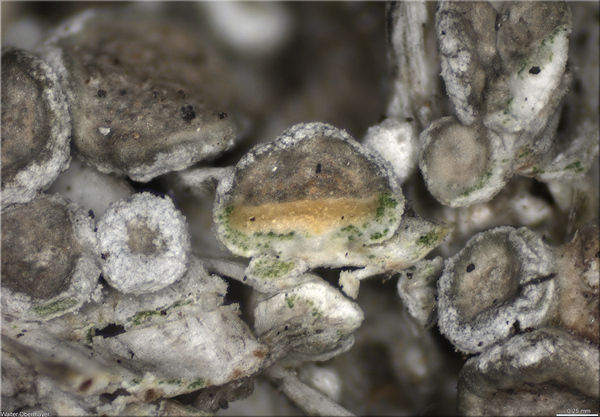Pertusaria bryontha (Ach.) Nyl.
Lichenes Scand.: 178, 1861. Basionym: Parmelia subfusca var. bryontha Ach. - Meth. Lich., 2: 167, 1803.
Synonyms: Pertusaria macrospora Hepp
Distribution: N - Frl (Tretiach & Hafellner 2000), TAA, Lomb.
Description: Thallus crustose, episubstratic, whitish to pale grey, more or less continuous to rimose, sometimes provided with sparse, isidia-like papillae. Apothecia lecanorine, immersed in thalline warts, with an expanded 0.3-2.5 mm wide, brownish to brown-black, concave to slightly convex disc surrounded by an irregular, often flexuose, raised, at first swollen, finally often reduced thalline margin. Epithecium dark brown to brown-black, K+ violet; hymenium colourless; paraphyses lax, branched and richly anastomosing; hypothecium pale. Asci 1-spored, broadly cylindrical, the apex with a broad ocular chamber, the outer sheath K/I+ blue, otherwise K/I-, with an inner extensible layer, Pertusaria-type. Ascospores 1-celled, hyaline, ellipsoid, (110-)150-200(-220) x (35-)60-90(-100) μm, the wall 12-20(-25) μm thick, with an outer, uniformly thickened layer and an unequal inner
layer. Photobiont chlorococcoid. Spot tests: thallus K- or K+ pale yellow, C+ red, KC+ red, P+ pale yellow turning orange, UV+ glaucous to orange. Chemistry: xanthones, stictic acid, gyrophoric acid and different accessory substances.Note: an arctic-alpine, circumpolar lichen found on mosses and plant debris, mostly over calcareous substrata, with optimum near and above treeline, up to the nival belt; probably widespread throughout the Alps, where it reaches the nival belt.
Growth form: Crustose
Substrata: soil, terricolous mosses, and plant debris
Photobiont: green algae other than Trentepohlia
Reproductive strategy: mainly sexual
Commonnes-rarity: (info)
Alpine belt: rather rare
Subalpine belt: very rare
Oromediterranean belt: absent
Montane belt: absent
Submediterranean belt: absent
Padanian area: absent
Humid submediterranean belt: absent
Humid mediterranean belt: absent
Dry mediterranean belt: absent
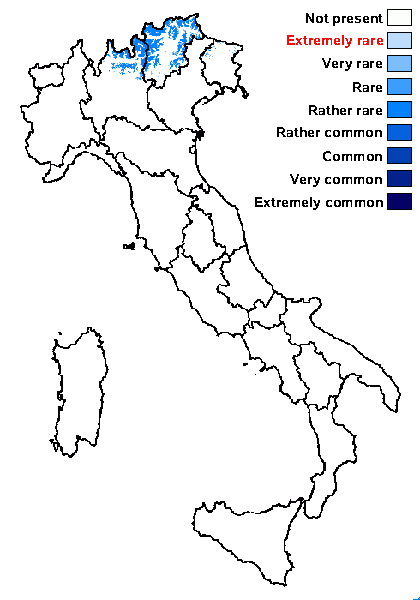
Predictive model
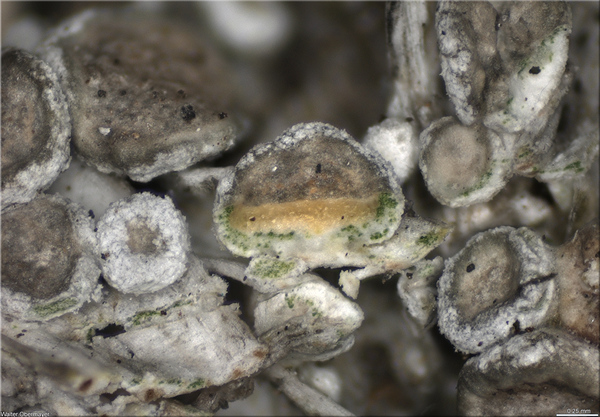
Walter Obermayer CC BY-SA 4.0 - Source: Lichens of Noricum - http://lichens-of-noricum.uni-graz.at/
Kammspitz; altitude: Austria
2015
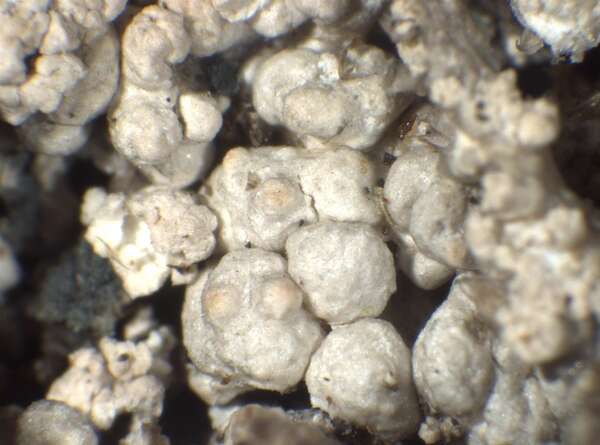

P.L. Nimis; Owner: Department of Life Sciences, University of Trieste
Herbarium: GZU Herb.Poelt (119-85)
2003/04/28
young fertile warts
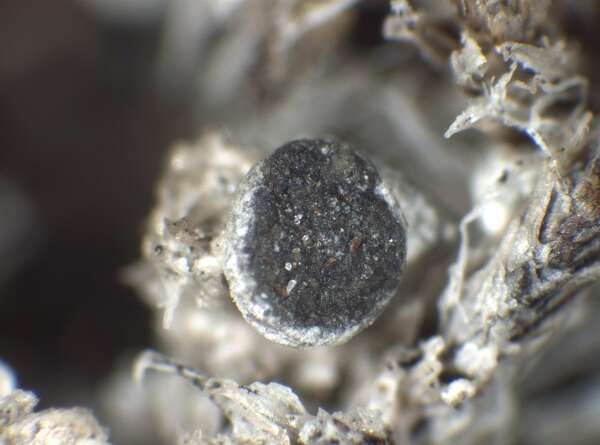

P.L. Nimis; Owner: Department of Life Sciences, University of Trieste
Herbarium: GZU Herb.Poelt (97-82)
2003/04/28
apothecium
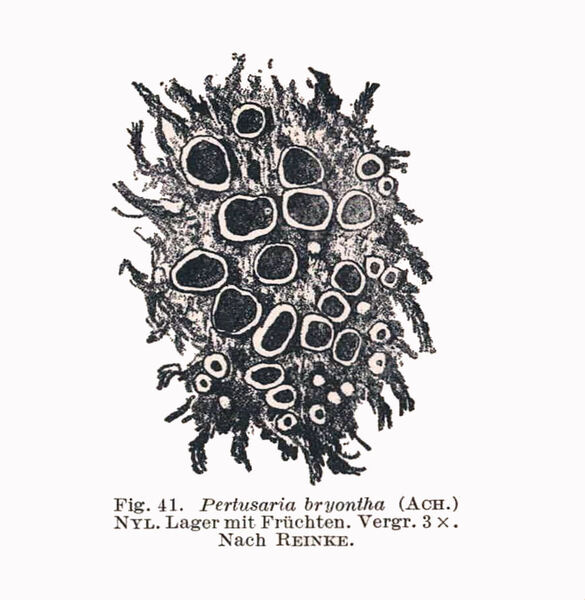
Erichsen C.F.E. 1936. Pertusariaceae. - In: Dr. L. Rabenhorsts Kryptogamenflora von Deutschland, Österreich und der Schweiz. Bd. IX, Abt. 5, T. 1. Akad. Verlagsges., Leipzig, pp. 321-512, 513-728. - Public Domain
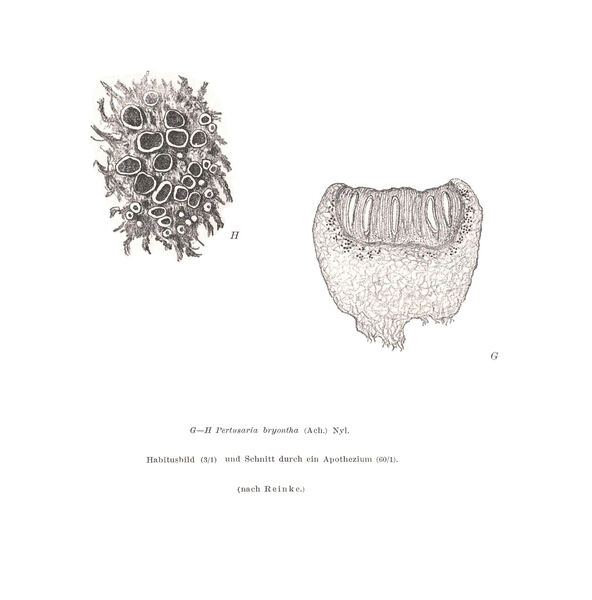
Zahlbruckner A. 1926. Lichenes (Flechten). In: Engler A. (ed.): Die natürlichen Pflanzenfamilien. 2nd ed., vol 8, W. Engelmann, Leipzig, 270 pp.
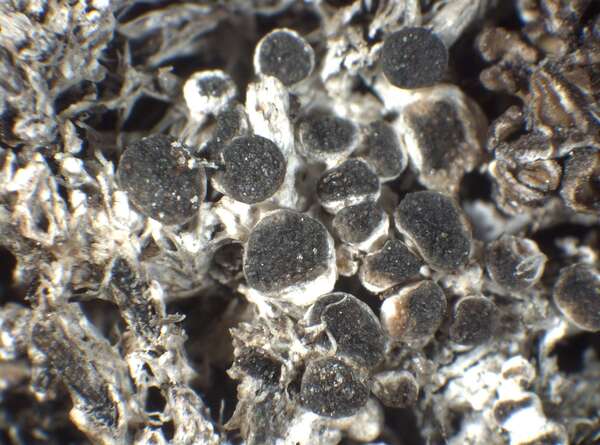

P.L. Nimis; Owner: Department of Life Sciences, University of Trieste
Herbarium: GZU Herb.Poelt (97-82)
2003/04/28
mature apothecia
Growth form: Crustose
Substrata: soil, terricolous mosses, and plant debris
Photobiont: green algae other than Trentepohlia
Reproductive strategy: mainly sexual
Commonnes-rarity: (info)
Alpine belt: rather rare
Subalpine belt: very rare
Oromediterranean belt: absent
Montane belt: absent
Submediterranean belt: absent
Padanian area: absent
Humid submediterranean belt: absent
Humid mediterranean belt: absent
Dry mediterranean belt: absent

Predictive model

Walter Obermayer CC BY-SA 4.0 - Source: Lichens of Noricum - http://lichens-of-noricum.uni-graz.at/
Kammspitz; altitude: Austria
2015


P.L. Nimis; Owner: Department of Life Sciences, University of Trieste
Herbarium: GZU Herb.Poelt (119-85)
2003/04/28
young fertile warts


P.L. Nimis; Owner: Department of Life Sciences, University of Trieste
Herbarium: GZU Herb.Poelt (97-82)
2003/04/28
apothecium

Erichsen C.F.E. 1936. Pertusariaceae. - In: Dr. L. Rabenhorsts Kryptogamenflora von Deutschland, Österreich und der Schweiz. Bd. IX, Abt. 5, T. 1. Akad. Verlagsges., Leipzig, pp. 321-512, 513-728. - Public Domain

Zahlbruckner A. 1926. Lichenes (Flechten). In: Engler A. (ed.): Die natürlichen Pflanzenfamilien. 2nd ed., vol 8, W. Engelmann, Leipzig, 270 pp.


 INDEX FUNGORUM
INDEX FUNGORUM
 GBIF
GBIF
 DOLICHENS
DOLICHENS
